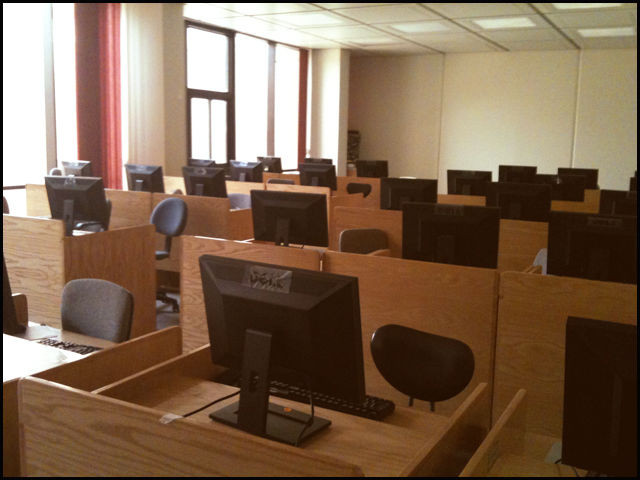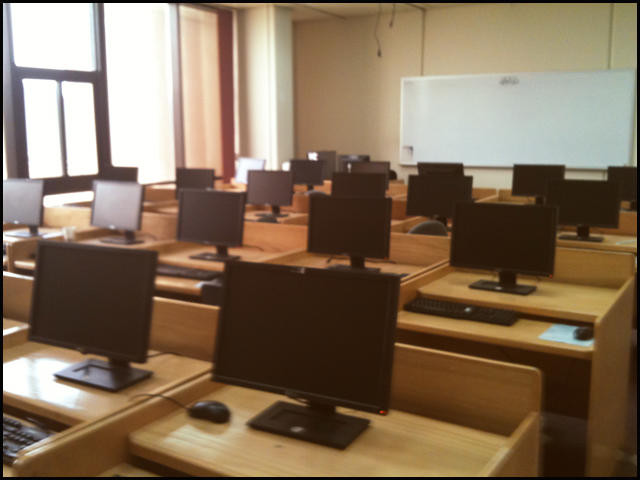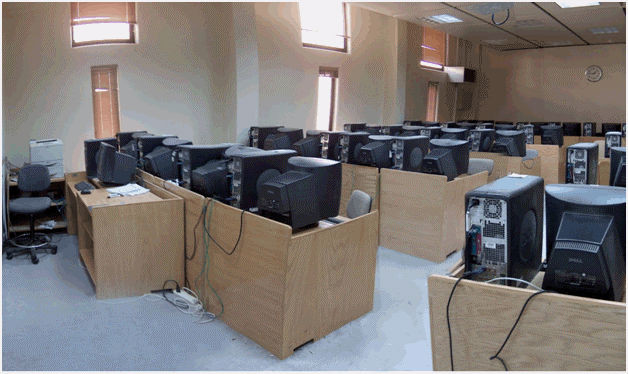CS - Laboratories
Computer Science Department Laboratories
- Operating Systems Lab.

Operating System lab is used to define Linux OS for students and the features for this system. In this lab, we teach students how to install and how to get Linux OS free from the Internet and how modify the source code (open source). Students write commands via the Unix Shell (commands line interface). Those commands include working with the file system, working with the files and folders, modifying time & date, using text viewing tools and text information tools.
- Artificial Intelligence Lab.

CSC 153: Object Oriented Programming (C++)
These Labs couples work on program design, analysis, and verification with an introduction to the study of Object Oriented Programming using C++. It is important in the construction of sophisticated computer programs. Students will be expected to write C++ programs, ranging from very short programs to more elaborate systems. Since one of the goals of this course is to teach how to write large, reliable programs composed from reusable pieces, we will be emphasizing the development of clear, Object Oriented programs that are easy to read, debug, verify, analyze, and modify.
1. To learn object-oriented design principles.
2. To gain experience writing programs in C or C++.
- Computer Graphics Lab.

The main propose of this Lab is directed to how student can design any object by computer graphics programs and modern Mac Pc’s. Starting with utilizing modern computer packages programs to design shapes until the student be familiar with all tools considered in the packages. Additionally, working tasks is devoted for applying the geometric transformation such as translation, scaling, rotation to obtain animations for any scene. The student will recognize that he apply practical phase for the discussed theoretical in lecture. Moreover, open GL is used that add more experience for student in designing computer graphics programs.
- Networks Lab.

CSC 214: Data Structures
These Labs couples work on program design, analysis, and verification with an introduction to the study of data structures. Data structures capture common ways to store and manipulate data, and they are important in the construction of sophisticated computer programs. Students will be expected to write C++ programs, ranging from very short programs to more elaborate systems. Since one of the goals of this course is to teach how to write large, reliable programs composed from reusable pieces, we will be emphasizing the development of clear, modular programs that are easy to read, debug, verify, analyze, and modify. Following are the main objectives to achieve from this Lab work:
1. To learn how the choice of data structures and algorithm design methods impacts the performance of programs.
2. To learn object-oriented design principles.
3. To study specific data structures such as linear lists, stacks, queues, hash tables, binary trees, heaps trees, binary search trees, and graphs.
4. To study specific algorithm design methods such as the greedy method, divide and conquer, dynamic programming, backtracking, and branch and bound.
5. To gain experience writing programs in C or C++.
- Assembly Language Lab.

Assembly Language lab is used to teach the student how to write assembly language programs and understand instructions and use it write programs, and understand addressing modes, and write a programs contains loops, stacks, and subroutines call. In this lab we use MASM.EXE, LINK.EXE, DEBUG and EMU8086.
- Internet Techniques & Web Programming Lab.

CSC 357: Internet Techniques & Web Programming
The main objective of this Lab is to provide students with the background to recognize and understand basic navigation techniques. Also, detailed understanding of the key technologies used in the implementation of dynamic Web applications using web languages, such as PHP, HTML and Javascript and languages for data storage and manipulation, such as MySQL. In addition, understanding of syntax and semantics of several Markup languages for use in information communication (e.g. XHTML, XML, CSS, etc.). In this lab, every student will install a local server and learn how to execute scripts. Also, Create valid XHTML pages containing headings, paragraphs, hyperlinks, lists, images, tables, frames, and forms. Finally, create and format a typical 5 to 10 page small business or personal Web site using all previously mentioned language.
